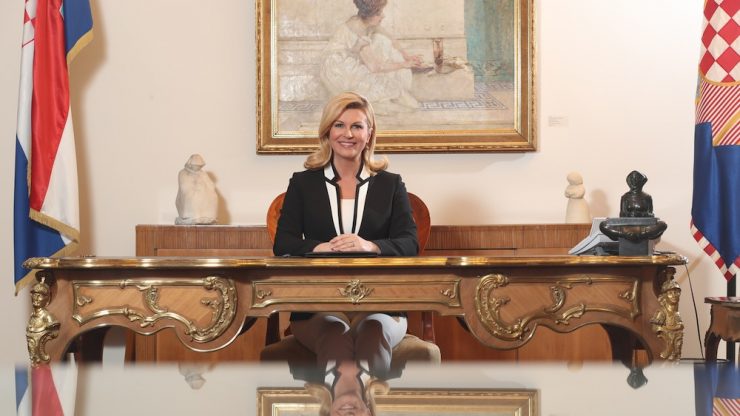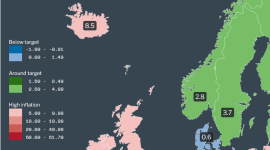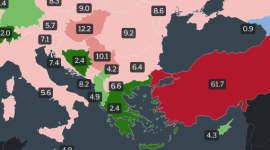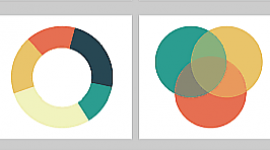On November 11, 2019, at 11:00, the current President of Croatia, Kolinda Grabar-Kitarović, presented her program for the upcoming presidential elections in Croatia. While she was already, at least informally, campaigning, this announcement marks the more concrete kick-off of her campaign.
The time and date were not selected accidentally. At the same time and date in 2014, Grabar-Kitarović announced her program for the first time she ran for President of Croatia.
According to the latest polls, Grabar-Kitarović is still a leading candidate beating her major opponents – Zoran Milanović, Miroslav Škoro, and Mislav Kolakušić.
However, Grabar-Kitarović’s approval ratings were varied. According to the last polls, conducted in October 2019, her approval rating is 42%, while 50% percent of respondents do not approve President’s work. While in the more developed democracies, like those in the USA, for example, approval rating polls are conducted almost daily, in Croatia, we get to see the data roughly every month, usually in its second half. So, once a month, we get to see and analyze Kolinda Grabar-Kitarović’s approval rating.
Interactive visualization of Grabar-Kitarović’s approval rating
For this post and visualization, I dug through dozens of monthly reports, news articles, and broadcasts, trying to collect all approval ratings. The final result is in front of you – you can explore Grabar-Kitarović’s approval ratings from the start of 2015, when she assumed the office, until now. This post will be updated regularly to track changes to her approval rating.
The majority of data collected here is taken from Crobarometar, a monthly poll conducted for one of Croatia’s TV broadcasters. Typically, there were between 960 and 980 respondents per survey with a margin of error +/- 3.3%.
To see a larger visualization, follow this link.
Analysis
November 2019 update
Currently, Kolinda Grabar-Kitarović’s approval rating is 37%, tied lowest on record (the same record was during August 2019). On the other hand, 55% (highest on record!) of respondents don’t approve the President’s work, with only 9% of them being uncertain.
Previous updates
As said earlier, at the moment, Kolinda Grabar-Kitarović’s approval rating is 40% in her favor and 52% against her. Only 8% of respondents didn’t have either a positive or negative inclination toward the President’s approval rating.
With more than half of people not being in favor of the president’s work – this is a worrying number for the President – even more so given that more than 50% of her disapproval lingers since July. Her current approval rating, 40%, is not the lowest she has ever had. In August 2019, the lowest yet recorded approval rate was only 37%.
This downward trend can be traced back to October 2018 – more than a year ago. First, the President relieved of his duty one of her advisors – Radeljić (December 21, 2018) and then, several months later (February 16, 2019), she claimed that “ZDS is not an old historical greeting” as she claimed before – under the influence of her advisors. ZDS, a shorthand for “Za dom spremni” – denotes the WW2 Ustasha regime greeting.
On the other hand, thanks to her very active cheering, rooting, and support of Croatia’s national soccer team at the World Cup in Russia (June 14 – July 15, 2018), her approval rate rocketed. For example, just before the World Cup, in June 2018, her approval rate was 46%. Right after the WC (with Croatia winning second place!), her approval rate reached a solid 57%. Only once did the President beat that rate – in October 2018, when it peaked at 58%.
From that point onwards, a steady decline in her approval rate can be noticed, reaching its minimum in August, as mentioned earlier in 2019.
Interestingly, the President’s approval rate started dropping right after the President of Serbia, Vučić, visited Croatia (in February 2018). This visit was surrounded by heavy criticism from both the right and left sides of opposition and the political spectrum.
Another notable moment happened in Warsaw (August 25, 2016) when President Grabar-Kitarović visited “The Three Seas Summit” – an initiative she envisioned with Polish President Duda. This Summit was widely documented, as well as her discussions and meetings with the US President, Trump. This propelled her approval ratings, but it had an even stronger effect on her disapproval rates, which dropped from 46% to only 33% right after the Summit (in September) and to even lower, 31% (in October).
A similar effect can be observed if we look at President’s participation at a NATO Summit, right after which her approval rating was at 50% in June and reached 53% in July 2016. This particular Summit was commented in wider Croatian public thanks, partly, to Grabar-Kitarović’s agile moving to the front rows of world leaders – rubbing shoulders with President Trump.
It seems that the President’s foreign policy moves and activities generally attract attention and quite often improve her approval ratings. Another example is the Višegrad Group (V4) meeting at the start of October in 2015. President’s approval rate at that point was 52%, only to reach 64% following the meeting. This was also her highest recorded approval rate. It must be noted, however, that this approval rate increase is not just due to the V4 meeting. A new, HDZ-led government (but with an independent PM – Orešković) was being formed at about the roughly the same time, so this conjunction of positive effects played out well for Grabar-kitarović.
Going back in history, say March 2015, we remember the President’s decision to remove Josip Broz’s bust from the Presidential Residence (“Pantovčak”). Although this was one of her election promises, it seems that this didn’t bring her any noticeable improvement in her approval ratings. On the contrary, her disapproval rates jumped from 30% in April, followed by a 38% increase in May 2015.
What to expect from the next presidential elections in Croatia?
President Grabar-Kitarović is entering this race with a noticeable, albeit shrinking, headstart in recent polls. She’s not alone in this race. Her primary competitors, Zoran Milanović, Miroslav Škoro, and Mislav Kolakušić, are also hunting for their chance to enter the second round of elections – one that is likely to be held in January 2020.
This article will be updated to follow the race. I will do my best to bring you new data, analysis, and commentary related to President Kolinda Grabar-Kitarović’s approval ratings and the state of the polls. Fascinating times ahead!
ABOUT THE AUTHOR
 President of Croatia: Kolinda Grabar-Kitarović. The official photo courtsey Office of the President
President of Croatia: Kolinda Grabar-Kitarović. The official photo courtsey Office of the President











